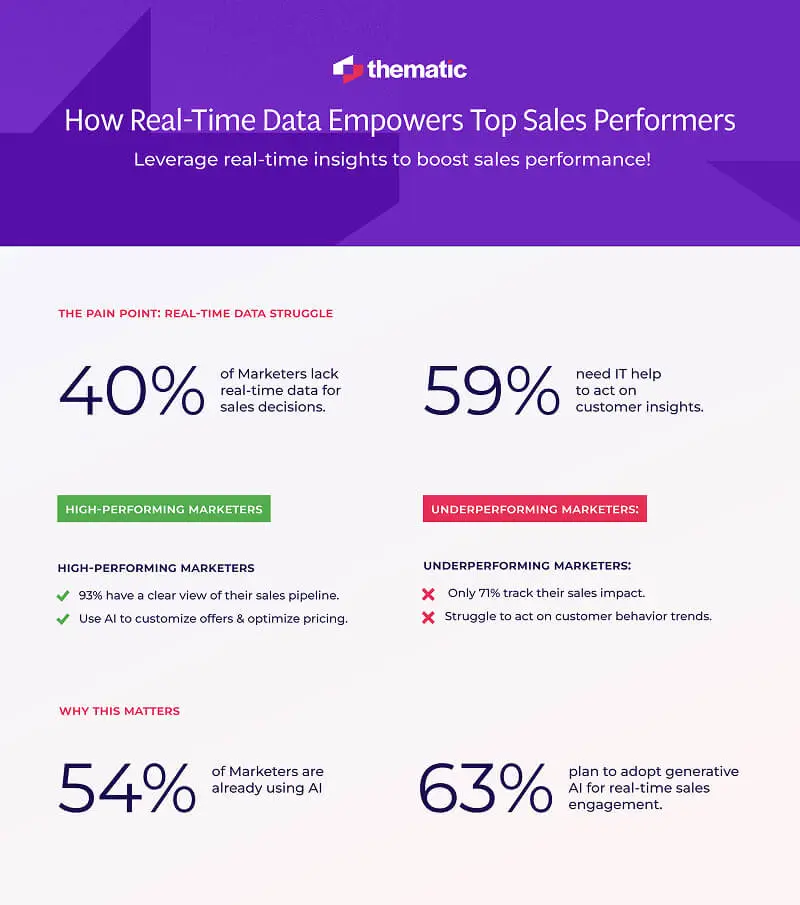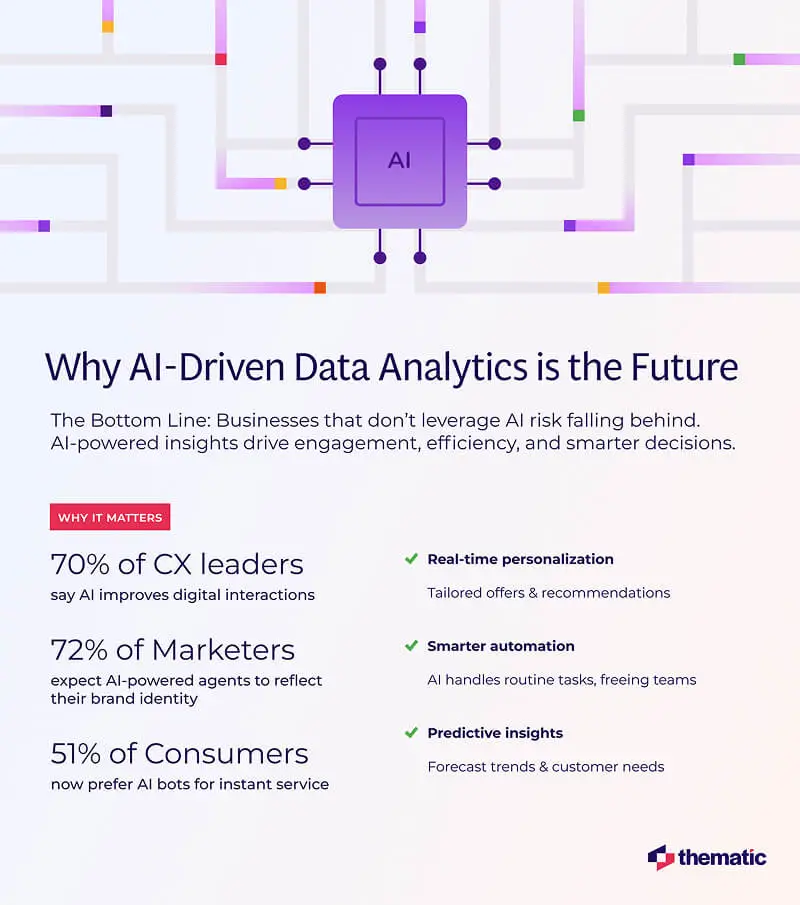
Discover how customer insights and analytics help businesses make data-driven decisions to improve marketing, sales, and retention.

Imagine knowing exactly what your customers want, what frustrates them, and what keeps them coming back—all without them having to spell it out. You’re probably liking the idea but thinking—I’m only human.
Well, the good news is, you don’t need psychic powers—just customer insights and analytics.
Just keep in mind: Businesses that use data to guide their decisions don’t just make better choices; they stay ahead of their game. They create more engaging marketing, build products that customers actually want, and improve retention by solving issues before they become deal-breakers.
If you want to know how they do this, keep reading. We’ll tell you how successful businesses use customer insights to grow; you can use their process as a template to grow your own!
Let’s first talk about how you can turn customer feedback into insights using AI.
We all know that every business collects customer feedback. But having feedback isn’t the same as understanding it. The real challenge? Making sense of it all and turning it into real improvements, you need AI-driven text analytics.
Instead of spending hours manually sorting through feedback, AI-powered tools like do the heavy lifting for you. AI:
So imagine a software company using AI-powered text analytics to process thousands of customer support tickets and NPS survey responses. The AI detects a common complaint about a confusing user interface, leading the company to redesign its navigation. After launching the update, AI tracked a 25% increase in positive feedback, confirming the change had improved user experience.
AI text analytics, powered by tools like Thematic Answers, transforms raw customer feedback into clear, actionable insights. Businesses that automate feedback analysis can spot issues faster, track trends, and make data-driven improvements—all without manual effort.
There’s pretty much a formula, and data has a big role to play. Successful businesses do the following:
Businesses use customer insights and analytics to:
Let’s dive into the details.
Let’s start with the basics—you can’t improve what you don’t understand. If you want to refine your strategy, you need to start by collecting the right data.
Your customers are constantly leaving clues about what they love (and hate). You just need to know where to look:
Tip: Spend some time on social media. Why? 4.9 billion people worldwide use social media in 2025, up from 4.6 billion in 2023. Your customers are most likely lurking there, so why not you?
Gathering the data is just half of the battle. Once you have the data, the real magic happens when you analyze qualitative data. Do the following:
Let’s look at DoorDash's case. This company leveraged customer feedback to identify late deliveries as a major satisfaction issue. Analyzing millions of reviews, support tickets, and surveys pinpointed key pain points, such as delayed food preparation and inefficient route planning.
These insights led to logistics improvements, including better driver scheduling and app optimizations, significantly reducing delivery delays. As a result, customer satisfaction improved, and churn decreased, proving that gathering and analyzing customer data is crucial for making informed impactful business decisions.

One thing to remember is that not all customers are the same. The key to high-performing marketing? Treating them like individuals, not numbers.
Customer segmentation means dividing your customers into groups based on shared traits so you tailor marketing and services more effectively. Think of it like a pizza place offering different toppings for different tastes—so everyone gets exactly what they want!
You may segment or group your customers according to:
When you know who your customers are, you can:
Here’s an example: A major retailer analyzed customer sentiment from reviews and feedback to tailor their email campaigns. Satisfied customers received loyalty rewards and exclusive offers, while neutral or dissatisfied customers got personalized recommendations or special discounts to re-engage them. By making emails more relevant, they saw a 15% increase in open rates and a 20% boost in conversions.
Tip: Voice of Customer (VoC) plays a crucial role in customer segmentation by revealing what different customer groups truly want, need, and expect. So, it helps businesses create more personalized and effective marketing campaigns.
What if you could predict what your customers want before they even know it?
Oh, yes, you can do it with predictive analytics!
Predictive analytics is like an oracle for businesses. It uses data and patterns to foresee trends, customer behavior, and future opportunities before they happen.
As a recent study found:
"Recurrent Neural Networks (RNNs) excel at processing sequential data, such as customer purchase histories or interactions with digital touchpoints over time. These networks are particularly useful for identifying customer segments based on their historical behavior and predicting future purchasing trends."
What does it mean? Using models like RNNs, businesses can forecast demand, prevent churn, and optimize marketing strategies. For example, companies can detect which customers are likely to cancel their subscriptions and re-engage them with personalized offers or reminders—before they make a final decision.
Picture this: A leading subscription-based company leveraged predictive analytics to identify customers likely to cancel before they actually do. Analyzing past cancellations, they found key warning signs—reduced engagement, fewer logins, and lower email response rates.
Using machine learning and thematic analysis software, they predicted at-risk customers and triggered personalized retention strategies, such as exclusive discounts and loyalty perks. This proactive approach reduced churn by 20%, proving that predictive analytics turns data into smarter, customer-saving decisions.
Guessing what customers want is risky. Successful companies don’t assume—they listen. By analyzing customer feedback, behavioral data, and sentiment trends, businesses can identify unmet needs, fix pain points, and build products or validate product improvements to truly match customer expectations.
Let’s see all these in action with Instacart’s case. By analyzing sentiment from surveys, app store reviews, and support interactions, they found that real-time tracking and estimated arrival times were often unreliable, leading to confusion and missed deliveries.
Using these insights, Instacart improved its delivery estimate algorithm, adjusted customer notifications, and optimized shopper scheduling to better align with real-time conditions. These improvements enhanced trust in the platform, reduced complaints, and ultimately led to a smoother, more predictable delivery experience.
The video below is another case worth looking into.
You’ve probably heard it before: it’s five times cheaper to keep a customer than to get a new one.
But loyalty doesn’t just happen—you have to earn it.
However, many businesses struggle with loyalty programs that aren’t fully accessible or integrated. Salesforce recently found that only 39% of marketers say their loyalty program functionalities are accessible across all customer touchpoints, and just 52% have fully integrated loyalty data across departments.
Clearly, many brands are missing opportunities to deliver seamless, personalized, and engaging customer experiences. You wouldn’t want to lose such opportunities.
Here’s how it works: A leading airline analyzed customer feedback and engagement data to refine its frequent flyer program. Travelers wanted more flexible rewards, priority boarding, and personalized upgrades, so the airline introduced tier-based perks, surprise rewards, and an improved mobile app for easy redemption.
These changes led to higher engagement, improved customer satisfaction, and stronger customer retention, proving that listening to customers makes loyalty programs more effective.
A great sales strategy isn’t just about having the right product—it’s about knowing exactly when, why, and how customers buy.
However, many businesses struggle to act on real-time customer behavior insights. In fact, 40% of marketers still don’t have access to real-time data for crucial tasks. Even among those who do, 59% require IT assistance to take action.
This delay can mean missed sales opportunities and less effective customer engagement.
Meanwhile, high-performing marketers (93%) have a clear view of their impact on sales pipelines, compared to 71% of underperformers.
The takeaway? Real-time customer insights give sales teams an edge, allowing them to personalize outreach, adjust pricing dynamically, and close deals faster.
But even if you do have access to real-time data, how you use them dictates your success (or lack thereof). Here’s what successful business people do with data:
✅ Dynamic pricing – Adjust prices based on demand.
✅ Personalized offers – Send relevant promotions at the perfect moment.
✅ Better sales training – Use customer feedback to coach teams.
Here’s an example of how it works: A B2B SaaS company leveraged real-time customer behavior insights to identify high-intent buyers and optimize their sales approach. By tracking product usage patterns, in-app interactions, and engagement signals, they pinpointed prospects most likely to convert.
Using AI-driven analytics, they triggered personalized outreach and dynamic pricing adjustments at the perfect moment, ensuring that sales teams focused on the most promising leads. This data-driven strategy increased conversions by 30%, proving that acting on real-time insights leads to smarter, faster sales decisions.

Customers expect fast, relevant, and personalized experiences—and if you’re not delivering them, your competitors will. AI-driven insights allow businesses to understand customer needs in real time, ensuring every interaction feels tailored and meaningful.
However, many businesses are still catching up. Zendesk reports:
This means that while some skepticism around AI remains, its use is quickly becoming an expectation. Businesses that fail to implement AI-driven personalization risk losing engagement, customer satisfaction, and, ultimately, sales to competitors who do.
Qualitative data analysis using AI is the way to go now.
Here’s a practical application: Leading e-commerce brands use AI-driven insights to create highly personalized shopping experiences that boost sales and customer engagement. They analyze past purchases, browsing behavior, and real-time interactions. Then, AI-powered recommendation engines would suggest product improvements tailored to each customer's preferences.
Also, chatbots and virtual assistants provide instant, personalized support, answering questions, resolving issues, and guiding shoppers through their journey. This allows salespeople to focus on high-level work.
AI also automates hyper-targeted marketing campaigns, sending personalized discounts and product recommendations at the perfect moment.
This level of customization is changing the game: AI-powered personalization drives a 30% increase in sales for many e-commerce brands.

Your data isn’t just for fixing problems—it can uncover new revenue streams.
Businesses that effectively analyze customer experience insights, intent signals, and market trends can identify untapped opportunities, optimize pricing, and expand into new markets.
And the impact is clear:
Here’s an example: A financial services company used advanced customer experience insights and AI-driven analytics to identify high-value customers who were previously overlooked. Looking into transaction patterns, spending behaviors, and service preferences, they discovered a segment of customers who were ideal candidates for premium financial products.
Using this data, they refined their marketing strategy, offering personalized financial solutions and targeted promotions, which led to a 15% increase in revenue while improving customer retention and satisfaction.

The best business decisions aren’t based on gut feelings—they’re based on data.
From refining marketing strategies and improving customer retention to developing products that truly meet customer needs, customer insights and analytics empower businesses to make informed, impactful choices.
With AI-driven data analysis, companies can anticipate trends, personalize customer experiences, and uncover new revenue opportunities—all while staying ahead of the competition.
Whether it’s predicting customer churn, optimizing pricing, or fine-tuning loyalty programs, the right insights lead to smarter strategies and better results.
So what’s your next move?
Try Thematic on your own data and start making smarter decisions today!
Small businesses can leverage free or low-cost tools like Google Analytics, social media insights, and survey platforms to collect customer data. Open-source sentiment analysis tools and CRM systems with built-in analytics also provide affordable options. Additionally, AI-powered solutions like Thematic can automate feedback analysis to save time and resources.
Common challenges include data silos (where different departments store data separately), a lack of technical expertise to analyze data effectively, privacy concerns, and difficulties in turning insights into actionable strategies. Overcoming these challenges requires integrating data systems, training employees in analytics tools, and establishing clear data governance policies.
Businesses must follow data protection laws like GDPR and CCPA, obtain explicit customer consent before collecting data, anonymize sensitive information, and provide transparency about how data is used. Regular audits and ethical AI frameworks also help prevent misuse.
Yes, real-time data analysis can help businesses detect emerging issues, such as declining customer sentiment, supply chain disruptions, or sudden drops in sales. By monitoring trends and feedback, companies can proactively adjust strategies, communicate effectively with customers, and implement solutions before problems escalate.
Join the newsletter to receive the latest updates in your inbox.